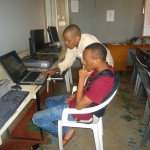Creating digital age learners through ICT projects:
 What can the project teach us?
What can the project teach us?
In Tanzania – like many African countries – libraries, computer facilities and kindergarten/day cares and recreation centers are only found in the cities and towns. Rural areas-Villages and Wards often have neither access to the above, nor a plan to get it, which results significant digital divide between rural and urban Tanzanians.
On basis of this, Tanzania Rural Empowerment Organization (TAREO) under change leader award from “Reach for change foundation initiated this ideas and become true .
The ideas was to use ICT facilities include computers and TV for rural education and local communities within defined center with the aim of solving the hidden problem of ;
- Luck of professional teachers
- Luck of Teaching and learning facilities.
- Kids infrastructure to encourage quick learning.
- Luck of generation that cannot compute in digital age and economy.TAREO has established two rural schools with similar models at Majengo village (Majengo Kids and youth technology center) and Himo ICT centre .Working with Community secondary schools we established Mobile Learning Unit to reach more isolated schools and villages in the strive to fulfill the goal of benefiting rural children,youths and community.
The quality of education provided by these centers was amazing in term of academic performance ,innovation and life skills not only for children but also for community around the projects.
OUR VISION, MISSION& LONG-TERM GOALS
Our vision is to see all rural communities specific children and youths have DIGITAL SKILLS with the knowledge, information access and skills necessary to generate an active and effective voice which influences their decisions in flavor of pro-poor sustainable livelihoods solutions from the age of 4 years.
Our mission is to facilitate participatory processes which empower marginalized rural people with knowledge and skills which enable them to engage constructively with government and other stakeholders to secure their social and economic rights.
OUR MODEL



SCALING
In the background of the pilot centers proving the TEEP concept works, TAREO next aim to scale up and bring the model to other rural areas throughout Tanzania where there is a lack of access to ICT based learning. To do this, we first need to reach these villages, create awareness of TAREO and make them become interested in replicating the pilot projects in their area. How this will be done depends on the situation in each village. There are two ways to go; either build a new school or franchise the TEEP concept to existing schools or kindergartens.Regardless of strategy, the local resources and support are essential to establish an ICT learning business.Thus, it is important to find the right connections and to get the village committed to a yearly monetary contribution that will be used to develop the center. Further, one must be aware that the environment can differ substantially from region to region so local adjustments to the TEEP model when it comes to organization and ownership as well as financial structure will most likely be needed.
Every new establishment will stick to TAREO’s focus on the general education and social developments of children and youths using ICT. They will also need to develop a business center,including the organization needed for operating it, where services will be offered at affordable costs. The goal is that the income from the business center will cover the running costs; mostly food, learning material and salaries, for the school and make the center as a whole financially self-sustainable. Having a financial structure that is economical viable in the long run is key.
The bigger we grow, the easier it will be to attract more partners, including funders and donors, to get involved and support replications and establishments of similar projects, which will be of every stakeholders benefit. It will also help inspire other villages, schools and potential franchisees to use the TEEP model in their local area. Read more








